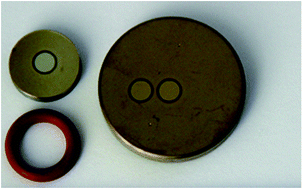Analysis of shallow depth profiles of titanium nitride and N-implanted titanium by GD-OES: the ‘hydrogen effect’ after the discharge startup and a correction thereof
Abstract
Disturbing effects, affecting depth profile analysis by GD-OES of the near-surface layers of Ti–N matrices, are described and attributed to the desorption of atmospheric gases including moisture from the inner surfaces of the glow discharge source. These effects are viewed as a perturbation, affecting sample atomization and excitation of analyte species. A formalism is proposed to correct for this perturbation when evaluating experimental data. The emission intensity of the hydrogen line at 121.567 nm is used as a variable expressing the magnitude of the perturbation. The modified quantification procedure is applied in the analysis of a series of titanium samples implanted with nitrogen.



 Please wait while we load your content...
Please wait while we load your content...